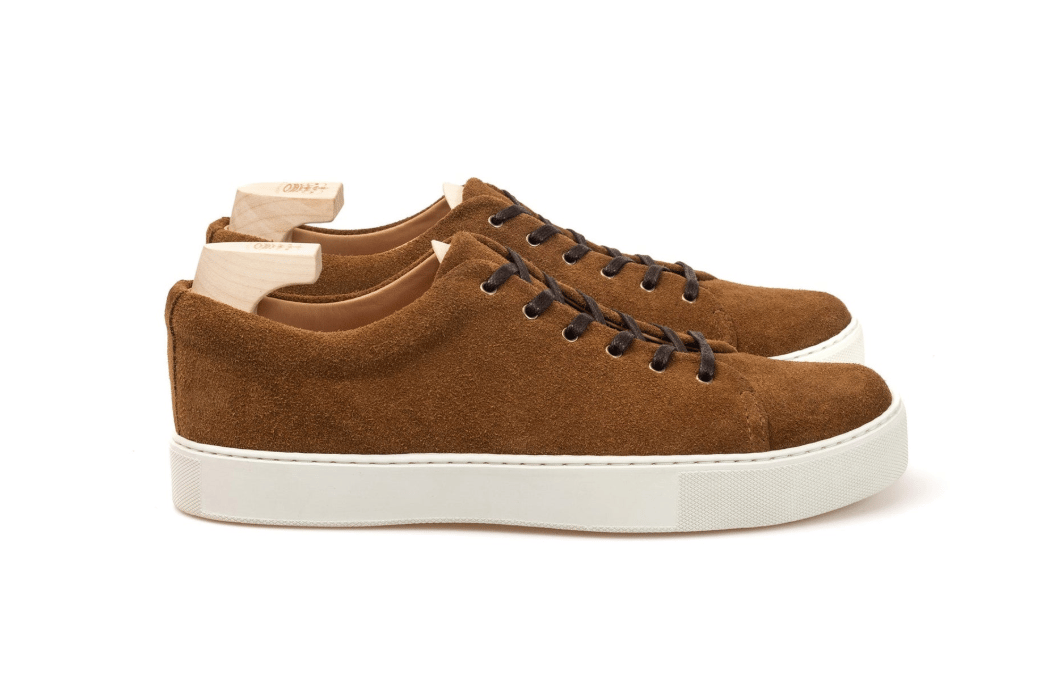- Heddels
- Posts
- Aug 6 - Know Your Shoe Leathers: The 10 Most Common Options
Aug 6 - Know Your Shoe Leathers: The 10 Most Common Options
Know Your Shoe Leathers: The 10 Most Common Options
We break down the ten most common options when it comes to shoe leathers. From roughout to patent leather — learn all about what's out there.
David Shuck

Man started making leather shoes over five thousand years ago out of deer and bearskin to combat the snow in the Italian Alps, but we’ve come a long ways since then. Even though the medium and purpose haven’t drastically changed, the way we produce and style hides to cover our feet has.
Leather is just a catchall term – there’s an array of skins, tanning methods, and treatments that distinguish all sorts of types of leather for every occasion. Here’s our breakdown of the most common men’s shoe leathers found in quality footwear, ranging from casual to formal, and neppy to smooth.
Terms to know:
Nap – The fibrous, fuzzy surface texture on certain types of leather.
Tan/tanning: The process of turning animal skins into leather.
Horween: A world-famous Chicago tannery that produces some of the most revered leathers.
Grain: Grain leather refers to the outer layer of a hide, which contains the natural grain or texture of the animal skin
Roughout

Patinated roughout via Red Wing Vienna.
Roughout leather describes a full-grain leather that has the untreated flesh side of the skin on the outside. Unlike suede, roughout hasn’t been treated to be super smooth, leaving the surface with a rough, pronounced nap. It also hasn’t been ‘split’, meaning it is a full-grain leather. The roughness of roughout depends on how much of the hide’s corium (see image below) the tannery has exposed while creating the leather. Roughout also comes in waxed/oiled varieties that strike a balance between smooth sheen and a rugged, soily texture.

Bovine flesh diagram via Dalgado.
Roughout was a favorite for Marine Corps combat boots in WWII as they didn’t require shining and were more breathable than smooth leather. While the roughness of roughout is visually pleasing and doesn’t require shining/polishing, it should be noted that it will get dirtier much quicker than a smooth leather, and you will definitely see a lot of denim bleed if you wear it with raw denim. This can, of course, add to the patina of your roughout footwear, but it’s something to consider if you prefer a more uniform patina.

Waxed roughout via Parkhurst
As roughout leather is worn, natural oils, water exposure, and friction from daily use smooth parts out and darken them. Contrary to belief, though, roughout is really easy to look after. Brushes can be used to remove dirt and dust and restore the nap, rubber bars can spot clean marks, and oils can be used in combination with brushes to restore some life back into tired, dirty roughout, if desired.
Roughout Leather Key Facts:
The flesh side of the hide is used as the outer, the opposite of a traditional smooth leather.
Has a rough, nappy texture, the severity of which is controlled by how much of the corium of the hide is untreated and left ‘rough’.
Typically provides a more casual look and is more breathable than smooth, finished leather.
Develops a rugged patina, with some areas of the material becoming smooth and darkened due to contact with oil and water from daily use
Can be waxed or oiled during production, creating ‘waxed roughout’, also known as ‘waxed flesh’. This process adds more water resistance but does not make the material waterproof.
Does not need polishing, but does need brushing from time to time to remove excess dust and dirt.
Can be oiled during the cleaning process, and subsequently brushed to revive the nap.
Leather protector can improve water resistance
Oak Street Bootmakers Field Boot, available at Oak Street Bootmakers for $518.
Grant Stone Edward Boot Dark Oak Roughout, available for $395 from Grant Stone.
Red Wing Iron Ranger in Hawthorne Muleskinner (oiled roughout), available at REVOLVR for $349.99.
Suede

Kudu suede via Crown Northampton.
Suede uses the flesh side of the skin like roughout, but the corium of the skin has been buffed and sanded down to an even texture. In fact, the corium is often split away from the rest of the hide in order to create a softer, more pliable material suitable for accessories like gloves. The word suede literally comes from the French “gants des suede“, meaning Swedish gloves.
Suede has a nappy texture, but it is much more uniform and not as pronounced as roughout, with shorter naps. Most makers in the realm of heritage and quality goods will use a full-grain suede, whereby the corium of a full-grain leather has simply been sanded/buffed to be smooth and even; however, split suede doesn’t always mean lower quality. A more formal shoe may require a split suede sewn onto a leather lining to reduce bulk, for example. In the case of sneakers, suede will almost always be split suede overlayed onto leather and/or textile.
The shorter nap of suede does mean that marks and water stains are more common, and many people find it difficult to clean. In truth, it’s not that hard to maintain a quality suede by using the suede brushes, protector sprays, and the correct cleaning products.
Suede Key Facts:
Made from buffing the corium on the flesh side of a leather to a smooth, slightly nappy finish.
Unlike roughout, suede is sometimes ‘split’, meaning the corium has been completely removed from the rest of the leather.
Water and other liquids stain suede. Water marks can usually be removed with a suede brush, but oil will usually stain.
Split suede panels are often used on sneaker uppers.
Suede protectors help protect against water marks
Suede can be cleaned with water and suede cleaner, as long as it is dried properly and subsequently brushed to revive the nap.
Meermin 101468 – Brown Suede – available for $235 from Meermin.
Alden Plain Toe Blucher Tan Suede G2401, available for $648 from Lost & Found.
Crown Northampton Adnitt Gat Shoe, available for $300 from Crown Northampton.
Veg-Tanned
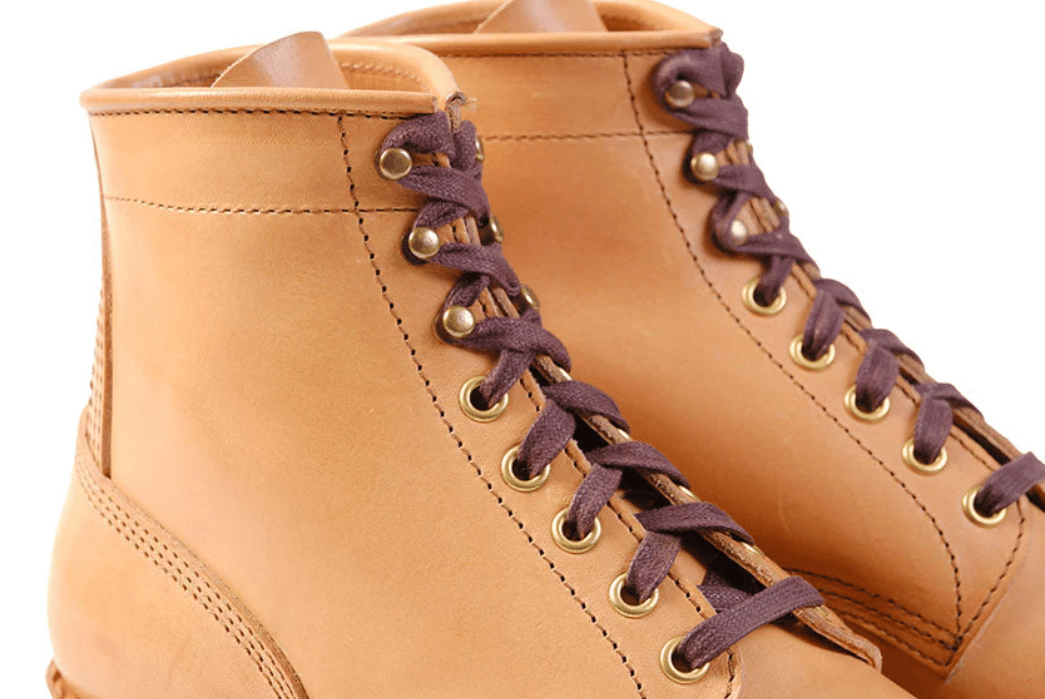
Vegetable-tanned leather via John Lofgren
Vegetable tanned leather is a more naturally processed leather, free of the chrome that is deployed on most of the bulk of mass-produced leather. Hides are tanned using vegetation matter and tannin extracts from the barks, leaves, cones, and chips of trees.
A lot is said about ‘natural’ veg tan leather (pictured above); however, vegetable-tanning is used to create a wide variety of leathers, from soft linings to hard outsoles, and many more. Natural veg-tan leather is particularly appealing to many as it darkens up over time, creating a very trackable patina that one can see happening almost in real time. Other light-colored vegetable-tanned leather will darken with use, while darker vegetable-tanned leathers typically lighten up in the most-used areas.
The chemical-free nature of veg-tan leather makes it ecologically sound to dispose of, but a lot of water is used in the tanning process. Unlike its chrome-tanned counterparts, veg-tan leather is known to mark and stain more easily than chrome-tanned leather. That said, it’s easy to clean and condition using readily available care oils and creams such as Venetian Shoe Cream.
Vegetable-Tanned Leather Key Facts:
Tanned with natural materials including wood chips, vegetable matter, bark, leaves, and more.
It can be combined with other tanning methods, so it may not always be 100% natural.
Quickly develops a rich patina, especially trackable on natural or lighter-toned leathers.
The tanning process uses a lot of water; however, 100% veg-tan leather is ecologically safe to dispose of.
Marks easily and can be water-stained, but is easy to clean and condition.
John Lofgren Steel Gang SW Boots Badalassi Carlo Vegetable Tanned Leather Bone, available for $1,178 from Redcast Heritage.
Parkhurst The Allen Stitchdown – Chestnut Veg Tan (618), available for $428 from Parkhurst.
GORAL Samara Vibram Sneaker – Maryam Natural Veg Tan Leather, available for $472 from GORAL.
Crown Northampton Harlestone Derby – Black Veg Tan Calf, available for $545 from Crown Northampton.
Nubuck

Timberland Nubuck via Stuart’s London.
In layman’s terms, nubuck basically sits between suede and a smooth, finished leather. It is made by sanding or buffing the top-grain of a hide to create a velvety texture with a short nap. It was initially made from deer or elk leather, hence the name’s inclusion of the word “buck“.
Nubuck is generally more durable than suede, due to its stronger fiber structure from the top grain of leather. But like suede, a lot of nubuck is vulnerable to water marks, which requires a cleaning regime similar to suede. Nubuck is commonly seen on sneakers and lower-level boots from the likes of Timberland & Clarks, but sometimes appears in our niche. Horween actually classifies their Chamois leather (discussed below) as an oiled nubuck.
Nubuck Key Facts:
Made by buffing or sanding the top-grain of leather until it has a uniform, extremely short nap.
Often thicker and more durable than suede.
Sometimes comes oiled.
Initially made from deer or elk leather, hence the name’s inclusion of the word “buck“.
Low-sheen unless oiled.
Sabor Jog Nubuck Grey, available for $169 from HAVEN.
Timberland 6″ Boot in Wheat Nubuck, available from $135 at Amazon.
Pull-Up
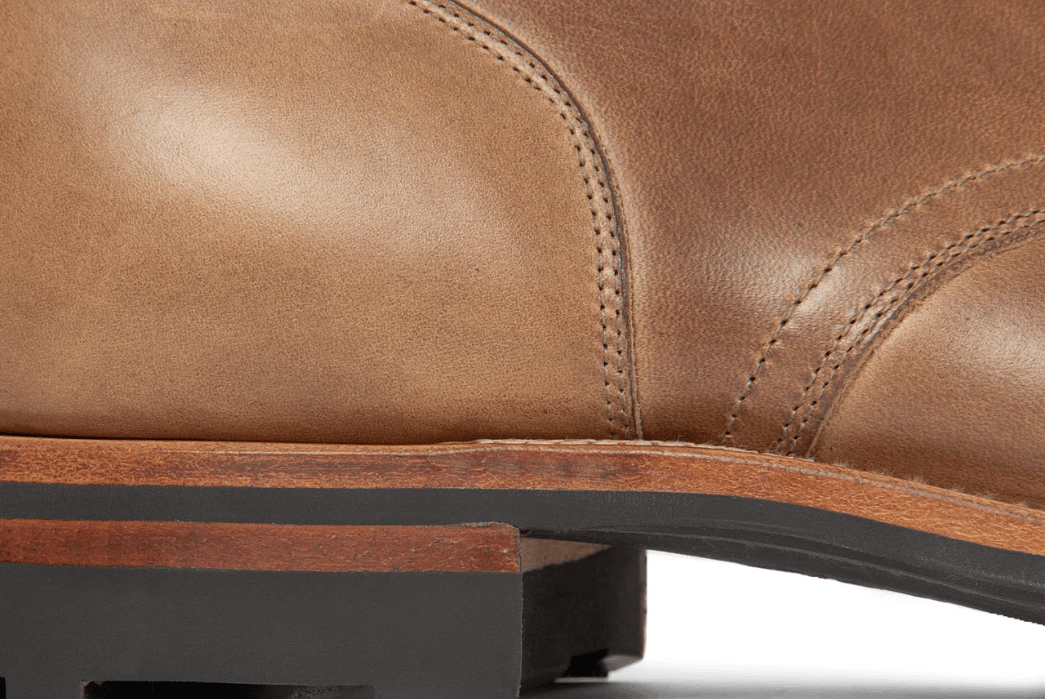
Horween Natural Chromexcel Leather via Horween.
Pull-up covers a broad swathe of heavily waxed and oiled leathers that have been hot-stuffed. Hot stuffing involves using steamed mills to impregnate the hide with oils and waxes such as beeswax, tallow, and neatsfoot oil to improve its suppleness, durability, and water resistance. This process leaves the leather subtle measures of luster and distressing, and allows it to absorb scuffs and scrapes like a champ. It breaks in easily, has a leather of weather-resistance — there’s a reason it’s so popular.
Hot-stuffing often causes the color to lighten when you pinch and “pull up” the leather, hence the name. The original pull-up is Horween Chromexcel, which has been a favourite of casual shoe and work boot makers since its introduction in the 1920s.

Patina on a pair of Grant Stone Diesel Boots in Dune Chromexcel via Stitchdown.
Pull-up leather ages brilliantly, lightening up in areas where the leather is stretched or around areas of creasing. It’s also very easy to care for. A brush can be used to maintain the leather, evening out scratches, etc. Brushing/buffing pull-up leather vigorously with a horsehair brush warms the leather and allows for the subtle distribution of its oils. More intensive cleaning can be done by gently applying saddle soap. Clean and dry pull-up leathers can be conditioned by applying Saphir Renovateur Cream or Venetian Shoe Cream.
Pull-Up Leather Key Facts:
Hot-stuffed with oils and waxes to improve suppleness, durability, and water resistance.
Horween Chromexcel is the most famous pull-up leather.
Ages brilliantly, softening further with wear and marbling in areas of stretch/creasing.
Has a mid-sheen.
Easy to clean and condition.
Available in a wide variety of colours. Undyed bovine pull-up tends to be a light brown, due to the stuffing process darkening the leather.
Typically cheaper than vegetable-tanned leather.
Grant Stone Diesel Boot Dark Olive Chromexcel, available for $435 from Grant Stone.
Viberg Service Boot® 2030 – Natural Chromexcel®, available for $1,040 from Viberg.
Grant Stone Moc Toe Derby Crimson Chromexcel, available for $412 from Grant Stone.
Chamois
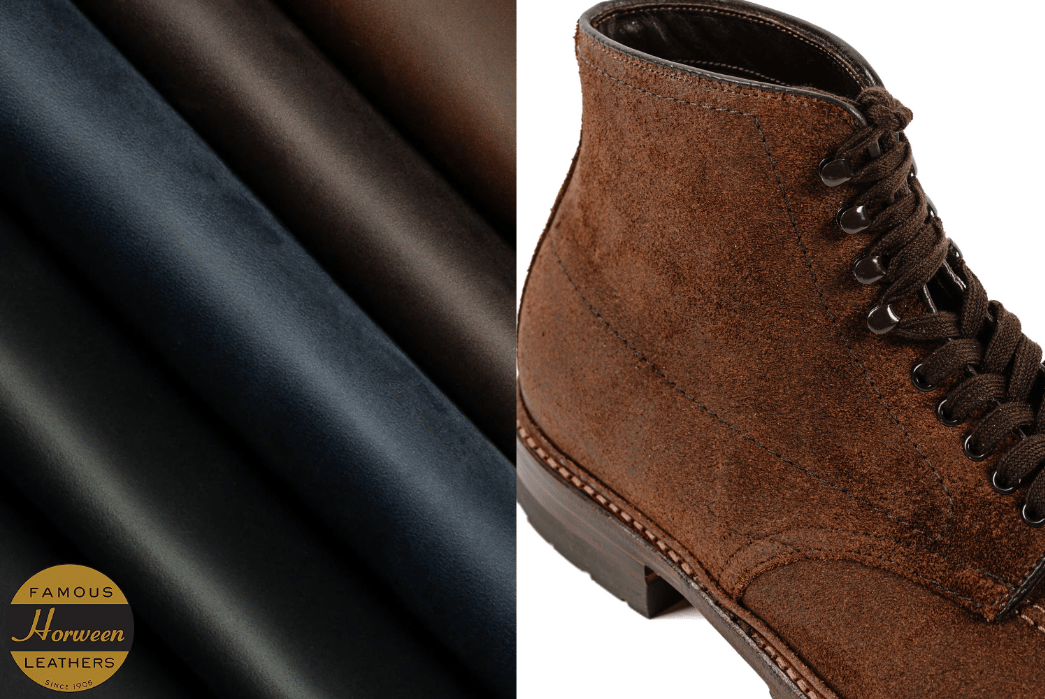
Both sides of Chamois leather via Horween & Lost & Found.
Although it’s pronounced the same, chamois leather is different from the shammy your dad buffs his car with. In this realm, chamois leather in footwear is a suede or nubuck that has been treated with oils on both sides of the leather. As such, both sides of chamois leather have a gentle sheen, with the flesh side having a very similar appearance to the aforementioned ‘waxed flesh’.
Mainly produced by Horween as a corrected grain leather (a term that means that the surface has been altered by buffing, sanding, or other process to make it more uniform, or achieve a certain texture), chamois has a slight suede-y texture on the grain side (similar to your dad’s shammy), and a nappy, soily texture on the reverse.
Chamois key facts:
A corrected leather that has been treated to have a uniform texture.
Different from car shammys
Both sides of the leather are treated with oil, giving them a slight sheen.
Similar in appearance to waxed flesh (waxed roughout).
Has a slightly nappy texture on the grain side, and a fuzzy, soily texture on the reverse.
Mainly produced by Horween in Chicago.
Alden Indy Boot Reverse Chamois with Commando Sole, available from Lost & Found for $692.
Tricker’s x Division Road Monty Chukka – 4497 – Vibram Vi-Lite – Horween Dark Rust Chamois, available for $745 exclusively from Division Road.
Scotch Grain

Scotch Grain via BLKBRD Shoemaker
Also known as Pebble Grain, Scotch Grain leather was developed in Scotland. Old Scots pioneered the texturizing process with the barley from old whiskey barrels that would shrink up the leather to create the signature pitted rhino-like appearance.
Nowadays, the pattern is generally embossed over an older calfskin. Once the skin is tanned and dyed, the textured pattern is applied with a heavyweight roller or press that has a pebble pattern etched onto its surface. The pressure from the roller or press permanently imprints the pattern onto the leather, creating the characteristic Scotch grain texture, which helps water to bead up and run off the shoe/boot.
Scotch Grain Leather Key Facts:
Made from calfskin that is tanned, dyed, and then embossed with scaly print.
The embossed nature of the print helps water to bead up and run off the leather, making Scotch grain footwear a bit more water-resistant.
Often has a high sheen.
BLKBRD Shoemaker Raife Longwing Blucher – Cognac Scotch Grain, available for $185 from BLKBRD Shoemaker.
Alden Scotch Grain Blucher, available for $736 from J. Press.
Shell Cordovan
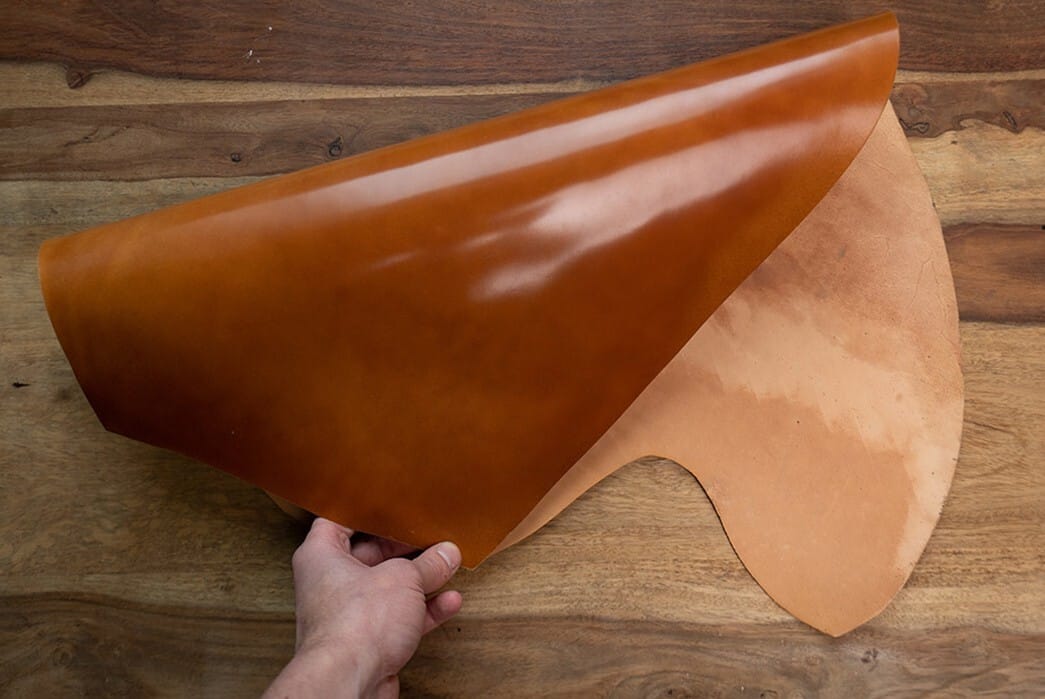
Whiskey Shell Cordovan via Shell Cordovan Toscana Italia
Often considered the holy grail of leathers, Shell Cordovan is one of the rarest and hardest-wearing shoe materials on the planet. It is made of the fibrous, subcutaneous tissue found on the hind quarters of a horse. The dense, poreless structure of the equine ‘shell’ makes it naturally more water-resistant than other leathers. This also means shell ripples instead of creasing and folding around stress points.
The process of producing Shell Cordovan takes 6-9 months to complete, with a complicated tanning process:
Prepping the hides: Hides are salted and stored until they’re ready for the tanning process. They are then soaked in lime to loose and remove the hair
Vegetable tanning: The hides are placed in vats with tannins from tree bark and other natural matter. This step lasts 30 days, allowing these tannins to soak into the leather. After the first round, the hides are treated again with more tannins and other chemicals to deepen the tanning process. This can last another 30 days.
Hot stuffing: The shell leather is then hot stuffed with oils, waxes, and other conditioning agents in large wooden drums.
Shell extraction: Highly skilled workers then shave down the hides to expose the smooth, dense “shell” layer underneath, carefully removing the softer outer layers of the leather.
Hand oiling: After shaving, the shell is hand-oiled to further condition and prepare the leather for its final appearance. This step also helps bring out the leather’s rich color and depth.
Drying and aging: The leather is hung to dry and age, sometimes for months, to allow the oils and waxes to settle into the leather, which helps with texture and durability.
Dyeing and polishing: The leather is dyed, often using aniline dyes, and then polished to create the high-gloss finish that is characteristic of shell cordovan.
All of this adds up to create a leather that can last for several decades if treated properly, including on footwear. The only caveat is that the rarity of high-quality equine hides and the labor-intensive nature of their tanning make Shell quite expensive, and limits availability to a handful of colours, the most iconic of which is Horween‘s burgundy No. 8.
Shell Cordovan requires a specific maintenance routine, involving regular brushing with a soft horsehair brush, gentle cleaning that avoids chemicals, and treatment with Cordovan cream from a brand like Saphir.
Shell Cordovan Key Facts:
Considered the holy grail of leathers.
Equine leather produced from the ‘shell’ of the hind quarter of a horse – the subcutaneous tissue between the skin and muscle.
The dense, poreless structure of this tissue means that Shell Cordovan is more water-resistant than some other leathers, and that it ripples rather than creases at points of wear.
Requires a complex and labor-intensive tanning process, which commands high prices on Shell Cordovan footwear and other products.
Availability in a limited number of colors, including Horween’s famous Color #8.
Has a high gloss sheen.
Requires care in the form of regular brushing with a horsehair brush, and conditioning with specific Cordovan cream.
Meermin 501040 – Burgundy Heritage Shell Cordovan, available for $395 from Meermin.
Crown Northampton Harlestone Derby – Horween Bourbon Shell Cordovan, available for $1000 from Crown Northampton.
Alden Mocc Toe Blucher Colour 8 Shell Cordovan G9602, available for $1,062 from Lost & Found.
Calfskin

Calfskin leather via Crockett & Jones.
Calfskin is the leather of young cows, making it thin and pliable with a fine grain that’s largely free of blemishes, but still very durable. These qualities made calfskin a popular choice for vellum in medieval and early Renaissance texts before the explosion in the use of paper. In shoes, smooth calfskin responds well to a high polish and can last for years if treated well. If you only have one pair of dress shoes, go for smooth calfskin.
Calfskin can also be made into suede or treated with wax to make it even more durable.
Meermin 101540 – Black Calf, available for $215 from Meermin.
Crown Northampton Overstone Derby in Snuff Jannus Calf Suede, available for $400 from Crown Northampton.
Patent leather

Patent leather via BLKBRD.
Patent leather cranks the high polish of calfskin to 11 with its glassy mirror sheen. The finishing process on patent was adapted from Japanese lacquering methods in the early 1800s to create the slick exterior, but nowadays, we generally use plastics. Patent is by far the most formal shoe material; as such, it typically comes in black to match your tuxedo.
BLKBRD Shoemaker Jules Loafer in Black Patent, available for $170 from BLKBRD Shoemaker.
Joseph Cheaney Kelly in Black Patent Leather Oxford, available for $422 from Brooklyn Tailors.
Like this? Read these:
What did you think of today's newsletter? |























